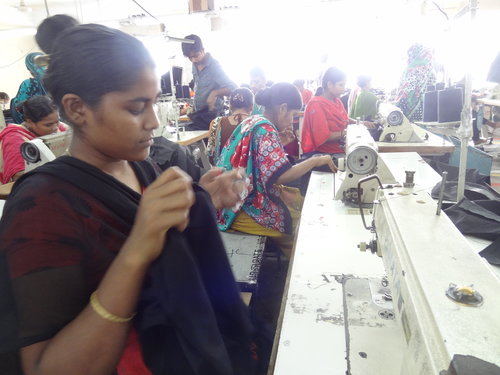NYU Stern Center for Business and Human Rights response to Penn State Center for Global Workers’ Rights Bangladesh research critique

February 12, 2016
The following letter is a response to a critique of the Center’s December 2015 report, “Beyond the Tip of the Iceberg: Bangladesh’s Forgotten Apparel Workers,” published by the Penn State Center for Global Workers’ Rights by Mark Anner, The Pennsylvania State University, and Jennifer Bair, University of Colorado at Boulder.
Dear Professors Bair and Anner,
We are writing in response to your February 10 critique of the NYU Stern Center for Business and Human Rights’ December 2015 report, “Beyond the Tip of the Iceberg: Bangladesh’s Forgotten Apparel Workers.” We dispute many of your assertions about our work, but are pleased that our research continues to garner significant attention from you and others interested in the global apparel supply chain.
Our report identifies 7,000 garment factories in Bangladesh. That list is the result of more than a year of analysis of a database we built containing 11,000 overlapping factory records from five different sources. We also conducted a comprehensive, on-the-ground survey of garment factories in two sub-districts in Dhaka. The report and the accompanying interactive factory map followed our 2014 study that was the product of more than 100 interviews and documentary evidence of the practice of subcontracting throughout the apparel supply chain in Bangladesh. We conducted five research trips to Bangladesh from 2013 to 2015 and have spent countless hours in factories, government meetings, company headquarters, conferences, and with workers and unions, in Dhaka, the United States, and Europe.
The headlines of our research are that there are thousands more factories and almost a million more workers producing garments for export than have previously been accounted for by global fashion brands, donor agencies, and academics. We also conclude that there has been a woeful lack of progress in actually fixing unsafe factories and that there still is no comprehensive plan to provide the resources to do so. Our research highlights that the lack of visibility and control in the supply chain is putting many workers at risk for safety and labor rights violations. The findings of our research about the prevalence of subcontracting have been reinforced by a growing body of news reports, documentaries, and academic research, including a forthcoming study from BRAC University in Dhaka.
We also study the various commitments and initiatives aimed at fixing factories that have arisen in Bangladesh since the collapse of five factories at Rana Plaza in April 2013. Our conclusion is that despite bold announcements and a proliferation of factory inspections, the vast majority of factories are not getting fixed. This was driven home with the sad news of another fire on February 2, 2016 at Matrix Sweaters, a factory that had been inspected. None of the initiatives has developed a system that is resulting in adequate resources to fix factories.
The prevalence of subcontracting and the lack of resources to fix a large number of direct and indirect sourcing factories are inconvenient truths for many of the players involved in the apparel supply chain in Bangladesh. In response to our most recent report, Siddiqur Rahman, President of the Bangladesh Garment Manufacturers and Exporters Association (BGMEA), stated boldly, “Subcontracting factories don’t exist.” And at a meeting of the World Trade Organization in December 2015, Tofail Ahmed, Bangladesh’s Commerce Minister, said our report “comes at a time when the image of the country’s garment sector is getting better after the Rana Plaza tragedy” and urged the media not to reproduce it. This kind of denial has become a common public response to our research.
Your critique follows a similar logic and is organized in four broad areas:
- Data quality – We constructed our database from five publicly available factory lists, which we collected through a web-based data scraping process in October and November 2014. The availability of data about factories from multiple public and private sources was a landmark for any garment-producing country, and we took advantage of increased transparency to build the first large, national-level database of factories. As with much data coming out of developing countries, there are limits to the data, which we acknowledged in an October 29, 2014 op-ed calling for better data and reporting standards. As we said then, “Access to better data now will help drive the kinds of changes that ultimately will make workers safer.”
Our analysis is based on what the government, the trade associations, and the Accord and the Alliance reported in October and November 2014. As we noted in the report, this data is both over-inclusive of factories that have been closed (such as those in Rana Plaza) and under-inclusive of factories that are not registered with any of these entities, namely indirect suppliers. Our map and the report are a reflection of documented factories at a particular moment in time.
While there are gaps in the data, it is a useful and unique contribution to have built a database of this size and scope. For the first time, our database and map present a picture of a country’s garment sector that is not dependent on the brands’ own reporting of their suppliers. The evidence shows conclusively that among documented factories, there are many that fall outside Western brands’ definition of their supply chains, as indicated by the Accord and the Alliance factory lists.
Our analysis of this database is grounded in our understanding of the regulatory and business processes that enable garment production in Bangladesh, which we have developed over the course of our research in Dhaka. You make several assumptions about the data that are not supported by evidence presented in your critique. For example, you assert that our estimate of 7,100 factories is “inflated by at least 2,000 factories” (p. 1). This assertion is not born out by your analysis of our research, nor have you indicated that it is based on any on-the-ground evaluation or new study on your part.
Additionally, you assert that “dozens and possibly hundreds of duplicates” remain in our database (p. 6). As we describe in the report, de-duplicating was an enormously challenging task that took months, and that we undertook using a careful and systematic approach (“Beyond the Tip of the Iceberg,” pp.16-18). We posted the factory list on our website so that other researchers could improve it and build on our original scholarship. We welcome serious efforts at analyzing and refining our list, but your wholesale rejection of our efforts is based on an unsupported conjecture.
- Prevalence of indirect sourcing – Recognizing the limits of what was officially reported, we undertook an ambitious field study in two sub-districts of Dhaka. The study was designed to assess the prevalence of indirect sourcing at a particular moment in time (June 2015). Surveying almost all of the factories in these two sub-districts, we concluded that 91% of them, including informal subcontractors, produced at least partly for export.
The survey tested the hypothesis, which you also advance, that some factories can be walled off from the export market because they only produce for domestic consumption (p. 6). The evidence is clear that factories at the bottom of the supply chain that rely on subcontracts do not categorize themselves in this way. Factory owners seek to fill their production lines with the most valuable contracts available to them. The lines between export and domestic production are fluid (“Beyond the Tip of the Iceberg,” pp. 23-25).
Your critique of our field study relies on the conjecture that “it is highly possible that surveyors inaccurately reported factory names and/or missed other factories on the official list as they walked the streets of Rampura and Tongi” (p. 8). You cite no evidence for this, and we stand by the careful and diligent work of our survey team. Again, we would welcome you and other researchers making additional contributions in this area by conducting your own field research.
Moreover, we believe that all workers, regardless of where the garments they produce are sold, are entitled to protections at work. It is precisely because the boundaries between export and domestic production are so fluid that we advocate a new, more comprehensive approach for factory safety and oversight that rests on shared responsibility for practical improvements that apply across wide swaths of the sector. Safety at work should not depend on whether a worker is employed by a direct sourcing factory that has foreign buyers.
- Number of workers – The database of documented factories we built includes employment data about the number of workers in each factory. This data is not complete or accurate for all factories, but the database as a whole represents an important step forward in factory-level reporting of employment statistics. Given that there are so many more factories than previously estimated, it is not surprising that there also are more workers. We estimate, based on the available data, that there are 5.1 million workers in the garment industry in Bangladesh. To be sure, there are multiple ways one can interpret the gaps in the employment data we have collected. But by any serious interpretation, there is little doubt that the number of factories and workers is much higher than previous estimates.
Your critique suggests that the “best available estimate is 3.85 million workers” (p. 10). You derive this conclusion by averaging unreliable estimates that pre-date the increased transparency reflected in the availability of online data in the fall of 2014. You also suggest that our analysis should be wholly disregarded because of the inherent challenges of wrestling with imperfect or complicated data. We disagree and stand by our conclusions.
- Remediation – You say, and we concur, that there has been progress in addressing factory safety in Bangladesh, but that much work remains to be done. You also say, rightly, that more attention should be focused on the delays in fixing factories and that the rate of progress should be accelerated. Our report reaches the same conclusions, but we also say that existing initiatives, including the Alliance and the Accord and their hundreds of company members, are not providing adequate resources to meet the need. In our view, the delay in fixing factories is a direct result of the stalemate that currently exists between factory owners and their buyers over the question of who pays.
This is why we have advocated a shared responsibility approach. For almost two years, we have called for the formation of a taskforce – led by those in Bangladesh in partnership with international stakeholders – to develop a practical roadmap for fixing both direct and indirect sourcing factories. The roadmap should include a formula for sharing the costs of this plan among fashion brands, their primary suppliers, governments, development and finance organizations, and philanthropies. In May 2015, we convened a meeting of factory owners and other experts in Bangkok to discuss this possibility. You dismiss this approach in favor of continued vigilance of existing commitments.
In sum, your brief relies on loose assumptions unsupported by evidence to discredit our research and advance a disproven hypothesis that the number of workers and factories in Bangladesh stands at 3.85 million and 5,000, respectively. Your conclusion is that the Accord and the Alliance provide more coverage of workers than the evidence shows. Your recommendation to fix the problem of unsafe factories and poor working conditions is to expand membership in the Accord and the Alliance and for “continued vigilance to ensure that stakeholders fulfill the commitments that have already been made” (p. 13). This recommendation misses the point that existing commitments do not go far enough, either in the number of factories and workers they cover or in practical plans to actually fund factory repairs for direct and indirect sourcing factories.
Undoubtedly, the facts we have presented over the last two years are uncomfortable. They reveal that existing solutions to address poor working conditions in the apparel supply chain do not hold up, especially for workers beyond the first tier of direct suppliers. You correctly identify our conclusion that the comprehensive evidence we have gathered over more than two years points to the need for “a fundamental rethinking of existing efforts, and reallocation of resources to address the massive number of workers that…are not covered by any existing safety program” (p. 3).
We spent considerable time communicating with you in recent months, and are disappointed to see that our good-faith efforts to explain our methods and research are not reflected in your brief. The premise you conveyed to us was that you were working on your own report on post-Rana Plaza reforms in Bangladesh. We look forward to seeing your original research in this important area.
We remain open to serious and thoughtful criticism of our research, while also remaining hopeful that additional research will be more directed at practical solutions to improve working conditions across the supply chain.
Sincerely,
Sarah Labowitz Dorothée Baumann-Pauly
 Global Labor
Global Labor


